Jula Harjo, Artist
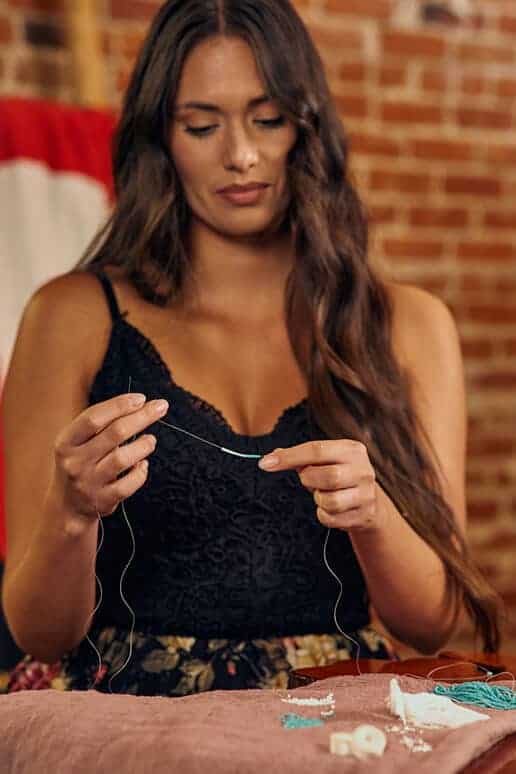
Take a good look at a piece of Native beadwork. A really good look. Each bead is unique. Maybe one is a slightly different color, or another one isn’t perfectly round. One is a tiny bit bigger than the rest; one is smaller.
Now, hold the artwork at a distance, and what emerges? A beautiful, recognizable pattern, cohesive and balanced. None of the differences show. Each bead, no matter its peculiarities, plays a role in creating something completely original that can never be replicated.
Beadwork is a fitting metaphor for tribal communities everywhere. Native people with diverse experiences, talents, skills, and knowledge contribute to the fabric of their distinctive cultures in countless ways, and each community is as unique as the people who compose it.
Beadwork artist Jula Harjo embodies that community spirit, not just in her craft but also in her everyday life.
Growing up in Idabel, Oklahoma, Jula was surrounded by the cultures of six individual tribes. Her maternal grandmother (Choctaw) met her maternal grandfather (Hochunk) at Haskell Indian Nations University in Lawrence, Kansas. On her father’s side, Jula’s lineage is Paiute, Shoshone, Seminole, and Mvskoke (Creek).
As a child, Jula attended the Kvlli Tuklo United Methodist Church just outside of Idabel. Established in the early years of the Removal, Kvlli Tuklo is one of the oldest Choctaw communities in Oklahoma. The original log building was erected in the late 1830’s. Here, in the congregation of her ancestors, she learned to sing hymns in the Choctaw language, but at home, her father spoke Creek. Today, Jula speaks mostly Creek in her own home, but Choctaw culture and language play crucial roles in her life as well.
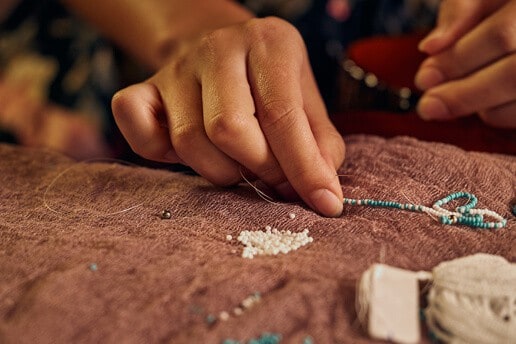
“It’s what I grew up with, mainly,” said Jula. “It’s what I was immersed in.”
While she was aware of Native American cultural arts and crafts, Jula didn’t pick up beadwork until 2020 when the COVID-19 pandemic was claiming millions of lives around the world. Indigenous communities felt the loss even more acutely as elders and culture keepers passed away, often taking their knowledge of tribal traditions with them.
During the lockdown, Jula needed something productive to do. When a friend sent her a kit with beading supplies, she gave it a try.
“I realized quickly that I really liked it,” she said. “I felt so much better doing that than being on my phone or computer. And I figured also that it would be something I could teach my daughter when she got older.”
Jula was the only person in her family who could bead, and she was happy to share her creations with her relatives.
"I gifted everything I made for the first year because I was just so excited to be able to make these things with my own two hands, and to give these gifts that literally come from my heart."
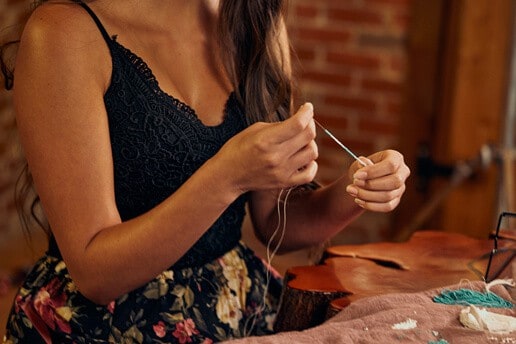
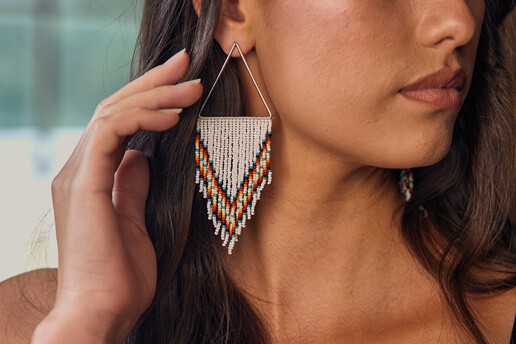
Beadwork is more than a skill, though. According to Jula, an artist must be in a positive frame of mind when they approach a project because they are putting a piece of themselves in their work and passing that on to others.
The hours and attention to detail it takes to create anything beaded by hand means each piece is unique and precious, but not everyone appreciates, or is even aware, of that. Sometimes people underestimate the value of these pieces at art shows and end up insulting the artist with low offers. Others may have inherited or been gifted hand-crafted Native items, and they simply don’t understand the importance of the gift. Sometimes, these items end up in thrift stores or lost to time.
When she travels, Jula often looks in thrift stores and pawn shops for Native American clothing and artwork that she can give back to tribal members who will care for them. In one instance, she found several Seminole patchwork items in a pawn shop in Wisconsin. She bought the entire lot for just $50.
She shared another story about a friend of her family who found a Choctaw dress at a Goodwill in Kansas. She bought the dress for five dollars and brought it to Jula’s grandmother, who now wears it with pride.
“It is kind of sad. She had mixed feelings about it because it’s something that was made by hand with love for certain people, but it ended up at a Goodwill. Who knows why? Was it just in the wrong bag? Did they do it on purpose? It’s kind of hard to see those things,” said Jula. “For me, personally, I like to buy them and take them home.”
Being an advocate for Indigenous artists and using her voice to educate others on the nuances of Native American art is a point of pride for Jula. She often promotes and participates in the work her friends from other tribes and communities are doing.
"I love being able to help my friends in any way that I can, whether that be modeling, whether that be sharing something on social media for them to help highlight a sale or a new line dropping," she said, "it really is important to have that kind of community."
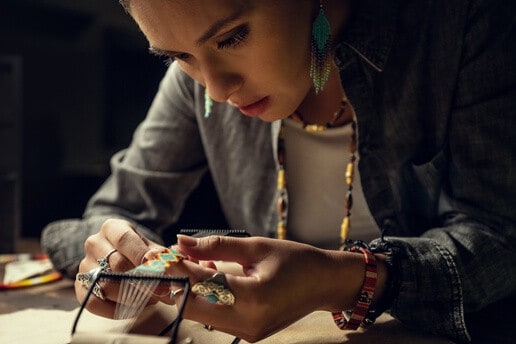
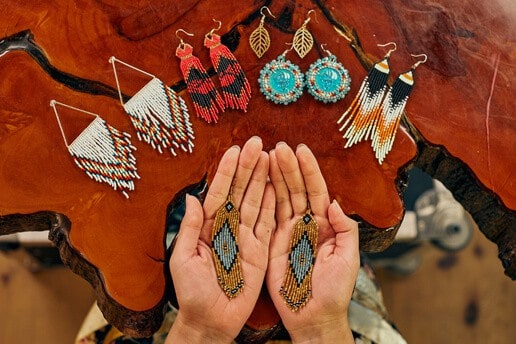
Jula also loves the idea of sharing beads and materials with other Native artists because when they use the gifts she sends them in their own artwork, it’s like they are bonded with each other across the miles. And she does the same with beads others send to her. It’s like a little of her friend is carried into her project. It gives her a sense of community to know that she is using beads that someone else has used before or that she is using beads that have been shared among a group of people who care for each other and for their crafts.
“Just to know that something like a shared hobby and a shared love that we have, it makes me feel a sense of resiliency, like ‘I’m still here; I’m still able to do these things and make these things for my family and friends.’ If it weren’t for my ancestors being so strong-willed and strong all around, I wouldn’t be here doing this.”
A sense of resiliency isn’t the only thing Jula gets from beadwork. She also sees it as an act of defiance. For generations, Native American ancestors were forbidden from speaking their languages and practicing many of their traditional arts and crafts. Today’s artists are working to reclaim the lost knowledge of their forebears, and sometimes that means setting boundaries for what is acceptable for non-Native people to do with Native arts and crafts.
The debate between what counts as appreciation versus cultural appropriation is not new, but it has been thrust into the spotlight in recent years, with the changing of sports team mascots and the removal of other harmful stereotypes from corporate branding.
Jula says, “It’s something that we haven’t had access to for a long time, and now that we do, it’s ours to take back. It’s ours to wear and use. We have a voice now to say, ‘No, that’s not okay.’ We have a sense of community; we have people to back us; we have people in higher places. We are CEO’s, lawyers, teachers.”
Now that young Native artists are emerging on the scene, Jula is excited to see the creative ways they are bringing Indigenous culture into their modern artwork, particularly in the fashion world. Because of her modeling experience, Jula has been called upon to participate in shows for Native fashion designers, who are incorporating symbols and ribbons in new and innovative ways. Bethany Yellowtail (Northern Cheyenne), creator of the fashion franchise b. yellowtail, turned heads with her power suit ribbon blazer and trousers, which is a twist on the traditional ribbon skirt, and Jamie Okuma (Luiseno, Shoshone Bannock, and Wailaki) is bringing traditional tribal patterns and beadwork to the world of haute couture. She even has a pair of beaded stilettos in the National Museum of the American Indian in Washington, D.C.
"I love going out in public and seeing people with tribal print or different Native brands," said Jula.
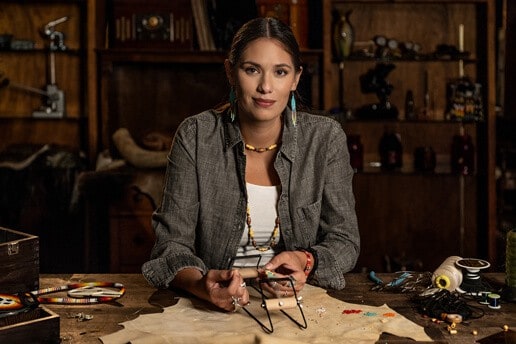
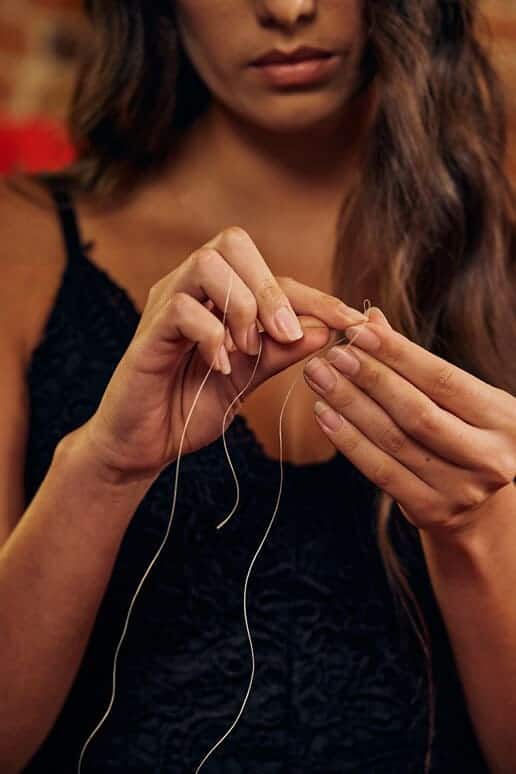
This resurgence of Native representation is also becoming more prominent in television and movies. Jula has recently accepted opportunities to be on-screen in Native productions. She is excited about her upcoming appearance in Marvel’s Echo, which is based on a Native American heroine, and a cameo in the award-winning television series Reservation Dogs, where she played a hospice nurse in the season two episode “Mabel.”
“Sterlin Harjo reached out to me for Rez Dogs and asked if I wanted to be on the show. That made me feel really, like, up there,” Jula said, beaming. She is particularly proud that Sterlin Harjo called her one of his favorite hymn singers in an interview. “That did something to me. That made me feel so good about myself,” she said.
Television shows like Reservation Dogs bring to light the everyday lives of Native people, rather than painting them as victims of circumstance or presenting them in ways that perpetuate harmful stereotypes. Jula finds it comforting that her daughter Tehcet (pronounced Dih-chit) will grow up in a world where seeing Native Americans on television and in film is normal and commonplace, rather than a refreshing surprise.
Tehcet’s first language is Creek, thanks to her mother’s teaching, but there are times when she prefers to speak English. It is then that Jula explains why speaking her Creek language is so important.
“We are in a safe place now to be able to speak our language and not be persecuted for it. Our great-grandparents weren’t allowed to speak their language. They went to boarding school, and they didn’t pass that on. For me to be able to pass that on to her and be able to continue this language journey is important.”
Tehcet often helps Jula in the kitchen when her favorite, grape dumplings, are on the menu. But she especially loves to do beadwork alongside her mother.
“I have a little lamp with a magnifying glass, and every time I turn that on, she asks, ‘Is it time to bead? Can I bead now? Is it my turn?’ So, she’ll get her little tray out and get her beads and pick the colors,” said Jula. “She loves to make really long earrings. They’re so random, but they’re so beautiful.”
For anyone who wants to learn how to get more involved in Native American artwork, Jula encourages them to support Native artists, ask lots of questions and learn everything you can about the language and culture. There are countless ways tribal members can carry on the practices of their ancestors and teach them to future generations. The future of Indigenous culture depends on people being inspired to pick up a needle and bead, grab a brush and paint, dig for clay and make pottery.
To learn more about Choctaw artists, please visit the Choctaw Artist Registry or see what classes are available at the Choctaw Cultural Center.
To learn how you can participate in traditional Choctaw activities, check out our Native November events.
Together, We're More
More Than an Artist
Choctaw beadwork artist Jula Harjo believes in the power of Native American artists to preserve and protect their cultures. Hear how she uses her voice and her art to speak up for Native communities everywhere.